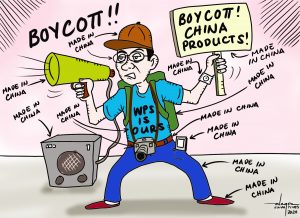Over the week-end police authorities reported to have confiscated some P7 million worth of shabu at the checkpoint in Licanan, Lasang, Davao City. The illegal drugs could not have been bound for another place. We can be certain of that.
Who were those who said that Davao is a drug-free city? Looks like past incidents of police drug buy-bust operations and arrests of several persons engaged in the distribution of shabu in the city are indications that the much prided claim of a “drug-free” Davao City is a thing of the past.
If such a huge transport of the prohibited drug worth P7 million is risked by some drug merchants to enter the city despite knowledge of existing checkpoints along the way, then in all likelihood there is a large clientele waiting for the substance.
And even if the law enforcers would justify by saying that the illegal drug transport has been aborted before it changes hands in the city, still it is clear that the trade has been ongoing and the demand is getting bigger.
Why is this happening and have the police been clueless as to the city-based consignees? Are the probers unable to exact names of suppliers and their addresses that they seem to be content in just arresting the drug couriers only?
We could only imagine if those who call our Davao City drug-free can still boast of the same given the volume of shabu confiscated while on its way to the local market.
*****************************
Every time Davao City’s downtown areas are flooded we cannot help but be reminded of the growing number of hillsides overlooking the city now being developed into residential subdivisions.
In fact along C.P. Garcia Diversion Highway in Maa (or is it part of Langub already?) some hills are actually flattened to give way to a residential enclave. Going up to Magtuod, any passer-by can see the sides on the left and right of the road being scraped, trees felled, areas fenced and what appear to be roads are now in place.
We can only assume that these property developments are for the satisfaction of the cravings of the rich and mighty for vantage locations of their residential abode.
With the way the developers are altering the natural contours of the mountain sides, they are already paving the way for future landslides and additional waste water dumped into the creeks nearby leading to Davao River.
Along the road in Tacunan going to Ula in Tugbok district, a large tract of land once a coconut plantation is now cleared of trees to give way to a housing subdivision. It is under the brand owned by a prominent businessman and politician.
With all the coconuts and other trees cut, there will be nothing left to hold rainwater when it comes. And naturally when the subdivision is developed concrete roads will cover almost every inch of soil thereat. Where then will the water go but to the nearby Talomo River.
Unfortunately, we have yet to hear of government projects that will mitigate the impact of these property developments to what these could contribute to the flooding of the city. Say, if the city government cannot install high dikes on both sides of Davao’s major rivers why cannot it explore the proposed project of the late Councilor Leonardo Avila III to dredge the rivers. This way it will increase the river depth thereby accommodating bigger volume of water to pass.
Or, why not the city pursue the construction of water catchments or even small impounding dams in appropriate locations to at least ease the flow of excess water during continuous heavy rains?
Why not solicit from experts ideas of projects that can be done for immediate but effective way of controlling soil erosion from the city’s already bald mountains instead of the usual resource-wasting “plant and run” activities? Why not the city look into the way the quarry operators are doing their thing along river banks?
In fact we are personally witness to the daily hauling of sand and gravel, small stones and big boulders by a quarry operator having concession area adjacent Callawa in Buhangin district. The hauling uses 15 to 20-tonner dump trucks passing by our place almost 24 hours daily.
It has been years already since the quarry operation started. And if one is to compute the area quarried based on the number of fully loaded trucks passing by our residence, it is easy to assume that the size could be enough to accommodate a relatively sized airport.
So what is left to prevent erosion in that particular area of the river bank? And how much silts are brought down the river bed?
No doubt the local government knows ow many more quarry areas are allowed in the city’s major rivers? Then we ask why are we exacted this vengeance of nature every so often?

